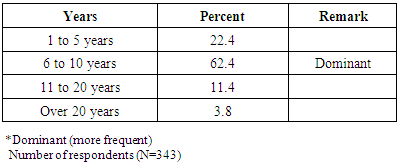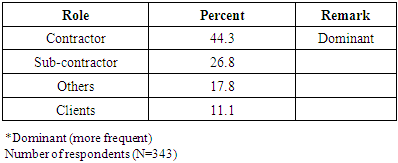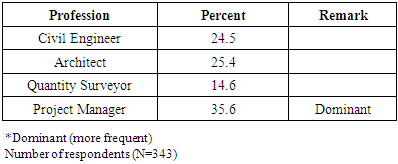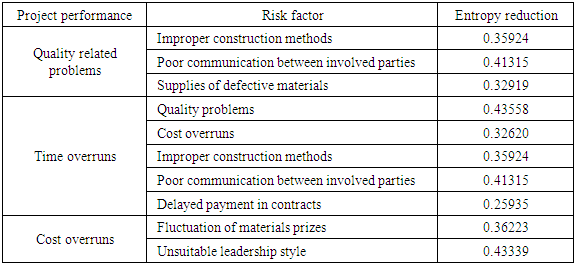-
Paper Information
- Paper Submission
-
Journal Information
- About This Journal
- Editorial Board
- Current Issue
- Archive
- Author Guidelines
- Contact Us
International Journal of Construction Engineering and Management
p-ISSN: 2326-1080 e-ISSN: 2326-1102
2017; 6(6): 221-234
doi:10.5923/j.ijcem.20170606.01

Methodology for Project Risk Assessment of Building Construction Projects Using Bayesian Belief Networks
Onengiyeofori O. Odimabo, Chike F. Oduoza, Subashini Suresh
Faculty of Science and Engineering, University of Wolverhampton, Wolverhampton, United Kingdom
Correspondence to: Onengiyeofori O. Odimabo, Faculty of Science and Engineering, University of Wolverhampton, Wolverhampton, United Kingdom.
| Email: |  |
Copyright © 2017 Scientific & Academic Publishing. All Rights Reserved.
This work is licensed under the Creative Commons Attribution International License (CC BY).
http://creativecommons.org/licenses/by/4.0/

The study aims to establish a risk assessment methodology to improve the performance of building construction projects especially in developing countries. A survey of randomly selected samples to evaluate risk factors experienced by construction practitioners was conducted based on the likelihood of occurrence and impacts on projects. A response rate of 53% comprising 305 contractors and subcontractors and 38 clients was received. Risk Acceptability Matrix (RAM) was used to rank/prioritise risk factors in order to determine critical risks that could affect building construction projects especially in developing countries. Bayesian Belief Network was then constructed by structural learning and used to appreciate the relationship amongst the risk factors. Results showed that critical risks affecting building construction projects were mainly improper construction methods, poor communication between involved parties, supplies of defective materials, delayed payment in contracts, fluctuation of materials prizes and unsuitable leadership style.
Keywords: Construction Projects, Project Risk, Bayesian Belief Network, Empirical Research
Cite this paper: Onengiyeofori O. Odimabo, Chike F. Oduoza, Subashini Suresh, Methodology for Project Risk Assessment of Building Construction Projects Using Bayesian Belief Networks, International Journal of Construction Engineering and Management , Vol. 6 No. 6, 2017, pp. 221-234. doi: 10.5923/j.ijcem.20170606.01.
Article Outline
1. Introduction
- The construction sector is an important engine for economic growth and socio-economic development in developing countries. Given the nature of the construction industry in developing countries, there is a high inherent risk factor of late or non-completion [1, 2], running over budget [3] and/or non-compliance with requirements among a majority of construction projects. Accordingly, Flyvbjerg et al [4] and Shrestha et al [5] show that cost overruns and time delays are as prevalent today as ever before. A high proportion of construction projects exceed their initial budgets with cost increases in the range of 50-100% being a regular occurrence and increases beyond 100% not uncommon, especially for larger more complex projects [4].More often than not a variety of stakeholders, including major participants of design teams, clients, contractors, project manager, subcontractors and suppliers are involved in building construction projects [6]. Each invests a substantial outlay of capital, in the form of time, resources or financial backing. Bearing this in mind, it is extremely important to consider interdependency between risks factors in building construction projects in developing countries [7, 3, 8]. Hence, risk assessment is an important part of risk management, which is used in making decisions in the process of identifying risk indicators as it determines the success or failure of the construction project. Since construction projects involve so many contracting parties, risk management helps these key participants to meet their commitments to minimise negative impacts on construction project performance in relation to cost, time and quality objectives [9].Risk in building construction projects relates to structural elements, dynamic elements and their interactions and within developing counties, these elements cuts across the broad categories of physical, logistics, environmental, financial, legal, construction, political and management domains [2, 10]. In construction risk management literature, different techniques and tools are proposed for the assessment of risk in construction projects [11-17], which do not capture the dependencies between risk items consistent to a real-world scenario thereby isolating the complexity of risk. In order to develop a systematic and integrated methodology for construction risk management, it is important to evaluate risk in determining the synergistic effect of the interaction between risk factors and thereby selecting optimal risk mitigation strategies. Moreover, these risks must also be linked to the project objectives, which in turn will influence the decision maker on the relative importance of each project objective [8].The use of tools such as cause and effect diagrams is one of the methodologies for construction risk management. These tools are useful in the modelling of conditional probability relationships among risks, and are very useful when handling risk variables [18]. However, it is not easy to construct relationships and it is even more complex than intuition-based analysis, so it has not been applied to construction risk management as a widely used methodology [18, 19, 17].The Bayesian Belief Network methodology, which is proposed in this study, goes beyond the normal explanatory or descriptive or traditional research methodologies in in a typical construction sector in a developing county using Nigeria as a case study. Bayesian Belief Networks (BBNs) offer an effective modelling technique for capturing interdependency between risks [20]. The BBNs are probabilistic models that represent system variables and their conditional relationships graphically as nodes and linkages in an influence diagram [21] and highlights a systematic and integrated process [18]. This research will contribute to the existing body of knowledge in construction risk management by using BBN model to establish cause and effect relationships between risk factors in a typical building construction environment.The Bayesian Belief Network (BBNs) models building construction risks as nodes and linkages in an influence diagram in order to understand the significance of the risks and consequently improve building construction performance. Another major contribution of this research is the rich insight gained in the cause and effect relationships of risk factors and how they lead to cost overruns, time overruns and quality problems in a typical building construction project.
2. Literature Review
- The focus of this research is to establish a risk assessment methodology to improve the performance of building construction projects in Nigeria. A brief overview of literature on construction risk management is carried out and presented in the following section.
2.1. Construction Risk Management
- All construction processes are risky and although risk is a somewhat multi-layered concept, in a construction context, it typically refers to the likelihood of a detrimental event/factor occurring during the lifespan of a construction project [22]. Risk management plays a relevant role in improving the performance of construction projects. Zou et al [23] describe risk management in construction project management context as a systematic way of identifying, analysing and dealing with risk associated with a project with an aim to achieve the project objectives. Consequently, Tohidi [24], described risk management as the process of identifying and assessing risks, with a view to reduce it to an acceptable extent. In order to achieve the targets, set for construction projects, the risks associated with the project need to be managed on a proactive basis [25]. This makes it necessary that construction project related risks should be identified and classified prior to the commencement of the construction project. According to Samantra, Datta and Mahapatra [50] in developing an effective risk management strategy the following questions may arise;1. What are the sources of risks, and what are factors that influence the risks? How can they be identified?2. What are the potential losses incurred by the adverse consequence of risks?3. How can risk be assessed?4. Which type of analysis: quantitative, qualitative, or semi quantitative analysis to be considered towards effective risk assessment?5. How risk can be categorised? What is the critical level of risks?6. What type of control measures should be chosen to mitigate the severity of risks?7. What benefits is an organisation likely to get, if risk management strategies are properly implemented?As a result, construction-related professional institutions such as the institution of Civil Engineers [26], the Association of Project Management [27] and the Construction Industry Research and Information association [28] agree that risk management process is made up of; risk identification and assessment (also known as qualitative risk analysis), quantitative risk analysis, risk mitigation and monitoring. Risk management involves a variety of stakeholders including clients, contractors, subcontractors, suppliers etc. Consequently, relevant risks identified need to be analysed and then allocated amongst partnerships, which is key to effective risk management [29, 30]. Risk assessment is described by the BSI [51] as the process of evaluating risks arising from a hazard(s), taking into account the adequacy of any existing controls, and deciding whether the risk is acceptable or require some control actions. It includes the identification of critical risk factors, and the analysis of these factors to determine the risk rating. Risk rating is the process for estimating the incident and severity of adverse effects likely to occur due to actual or predicted interaction to hazardous event. It is the end product of risk assessment process that can be used by the management to develop control strategies for eliminating or mitigating the risks. In this report, risk has been described as a function of two parameters- (a) the likelihood, which is the probability of an undesirable occurrence, and (b) the impact, which is the degree of loss if the undesirable things occur Kuo [52]. Therefore, using a mathematical description, risk rating can be calculated to apply a Bayesian belief network:
 | (1) |
2.2. Classification of Risk in Building Construction Projects
- There are numerous ways in which risks can be classified. A typical pattern in risk management approach is based on the classification of risk sources as external and internal factors for developing a risk breakdown structure and it suggests that while external risks are those that originate from areas beyond the range of organisation control, internal risks are those that an organisation’s management can directly control and influence [33]. This is established in the works of Tah and Carr [34] who in addition to categorising risks as internal and external also assign risks with respect to whether they occur in a local context or a global. Aside from this sort of grouping, risk factors are also identified and placed in the specific phase in the construction process where they typically are relevant; examples of these include development risks, construction risks, operational risks and on-going financial risks [35]. When assessing these risks, Hopkinson [36] stresses the importance of not relying on a single risk management tool and warns that the common approach of applying the same risk management method to every new project is contrary to best practices. Instead, Hopkinson [36] insists that best practices would entail the intelligent application of principles and the selection of appropriate techniques to each individual project. Drew [49] has categorised risks into five groups:1. Opportunities- events presenting a favourable combination of circumstances giving rise to the chance for beneficial activity;2. Killer risks- events presenting an unfavorable combination of circumstances leading to hazard or major loss or damage resulting in permanent cessation of operations;3. Other perils- events presenting an unfavourable combination of circumstances leading to hazard of loss or damage leading to disruption of operations with possible monetary loss;4. Cross functional risks- common risks leading to potential loss of reputation;5. Business process unique risks- risks occurring within a specific operation or process, such as withdrawal of a particular product for quality reasons.However, it is argued by Hillson [53] that opportunities and threats are not qualitatively different in nature, since both involve uncertainty which has the potential to affect project objectives. As a result, both can be handled by the same process, although some modifications may be required to the standard risk management approach in order to deal effectively with opportunities. However, the downside of risk will be the focus of this report especially for those affecting construction companies in developing countries.Odimabo and Oduoza [2] have described a comprehensive classification of risk factors broken down into Physical risk (supplies of defective material, fluctuation of material prices, low productivity of equipment, shortages of materials required, insecurity and theft, bribery and corruption, vandalism), Environmental risk (environmental factors (flood, etc.), rain effect on construction, hot weather effects on construction, difficulty to access site), Design risk (defective design, non-coordinated design, inaccurate quantities, lack of consistency, rush design, shortages of qualified firms, unqualified designers), Logistic risk (shortages of skilled labor, low productivity of labor, delay in equipment delivery, failure of equipment, fluctuation of labor prices, undefined scope of working, high competition bids, poor communication, inaccurate project program), Financial risk (delayed payments, inaccurate estimates, incomplete documentation, financial attraction, unmanaged cashflow, exchange rate fluctuation, monopolizing of materials, difficulty to get permit, inflation and sudden changes), Legal risk (legal disputes, delayed dispute, local labor, ineffective enforcements, modification of laws, no specialised arbitrators), Construction risk (rush biddings, lack of experience, lack of database, lack of coordination, improper construction, improper quality and H&S, insufficient understanding, low salaries, unavailability of specialised companies, undocumented change orders), Political (unqualified decision makers, instability on projects, lack of transparency, political orientation, new governmental acts, unstable security circumstances), and Management risk (ambiguous planning, poor resource management, changes in management, unavailability of contractor’s pre-qualification system, unqualified owners, slowness of the owner’s decision making process, information availability, poor site management, poor communication between involved parties).After risks are classified, they are not left unattended in the implementation phase of construction projects. The outcome of risk analysis enables responsible parties to understand the risk impacts, and subsequently plan and undertake effective risk mitigation actions to curb the effect before or when they occur. However, a prevalent issue of concern is the communication of construction projects risks, which tends to be poorly delivered, incomplete in its delivery and thoroughly inconsistent [37]. Consequently, the various contributors to the construction project lack the necessary shared understanding of risks and are therefore unable to enact any effective early warning measures or strategies for mitigating risks that stem from problems rooted in decisions taken elsewhere in the organisational structure [34]. Furthermore, as Kutsch and Hall [38] point out, a large share of the research on risk management in projects focuses on developing methods for conducting risk analysis whereas relatively few studies evaluate the effectiveness of said methods. Nonetheless, Shenhar et al. [39] establish that there is a striking need for risk management procedures, a need that is greater the more grand and complex the project becomes.
3. Research Method and Procedures
- A BBN methodology is developed for building projects with a view to alert project participants of their impact, to improve the performance of building projects.
3.1. Bayesian Belief Network
- Bayesian Belief Network (BBN) is a graphical framework for modelling uncertainty. BBNs have their background in statistics and artificial intelligence and were first introduced in the 1980s for dealing with uncertainty in knowledge-based systems [40]. They have been successfully used in addressing problems related to a number of diverse specialties including reliability modelling, medical diagnosis, geographical information systems, and aviation safety management among others. For understanding the mechanics and modelling of BBNs, interested readers may consult Kjaerulff and Anders [41]. The BBN structure can be constructed manually. The identification of probability network structure is not as simple as it might be using a normal qualitative graph [41]. Therefore, modellers need to understand the structured approach to network structure identification in order to ground a basic knowledge, particularly in the large-scale BBN. Neil et al. [42] proposed the following idioms as an approach to eliciting the BBN structure in order to support the building of the BBNs, see Figure 1.
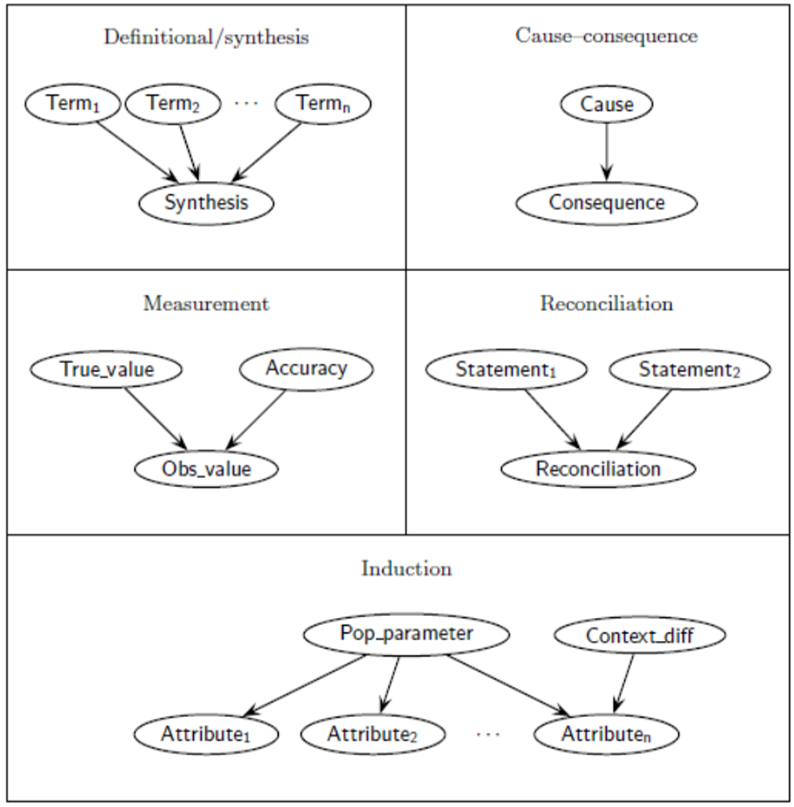 | Figure 1. Types of BBN model structure (idioms) [42] |
3.2. Modelling Approach
- The process for the development of our proposed framework is shown in Figure 2. The Bayesian Belief Network is selected for this research to model building construction risk analysis. BBN’s are probabilistic models that represent system variables and their conditional relationships graphically as nodes and linkages in an influence diagram. The BBN is a useful methodology for construction risk management with a systematic and integrated process [18].
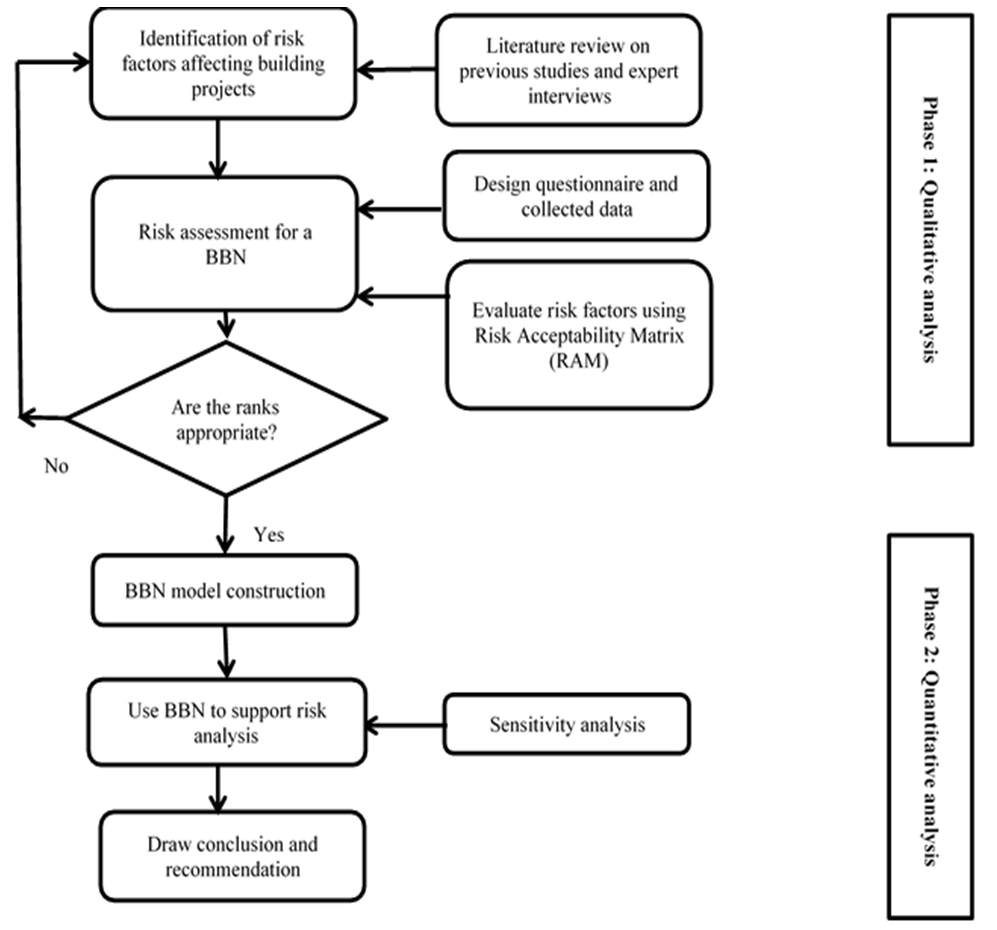 | Figure 2. Risk management framework for building construction projects using Bayesian belief network |
3.3. Description of Respondents
- The sample selection procedure adopted in this research is the random sampling. The target sample in this study comprises of contractors, subcontractors and clients. This was deemed the most appropriate target for any research seeking to apply scientific management techniques in construction project management. The following factors served as the basis for selecting the sample: size; experience; share of the industry's business; expertise; and specialisation. The Tables below provides data obtained based on work experience, role on the project and their profession.Table 1 shows that most of the respondents had 6 to 10 years working experience, followed by those with experience of 1 to 5 years and the rest of the respondents with over 20 years. This indicates that most of the respondents have sufficient experience in construction projects. Hence, they can properly assess the likelihoods of risk occurring and the magnitude of risk in a building construction project. Consequently, Table 2 shows the distribution frequency of respondents according to their roles in building construction projects. Contractors and sub-contractors were represented the most followed by other respondents which had other project roles such as consultants, architects, engineer etc. while the least were clients. This indicated that a large number of the respondent in the survey have the ability to understand and discuss the main issues related to risk management in the building construction sector. Furthermore, Table 3 shows the distribution of respondents based on their profession. It is seen that the respondents were professionals, who theoretically were capable of providing answers that reflected their knowledge and overall professionalism. Table 3 shows that the majority of the samples were project managers followed by architect, civil engineer and the least were quantity surveyor. This indicates that project managers were deeply involved in the survey and their views reasonably obtained.
|
|
|
3.4. Results and Discussion
- 650 questionnaires and covering letters were distributed to 38 construction companies across Port Harcourt, Yenagoa and Owerri, explaining the purpose of the study. For logistic and cost reasons, the sampling was restricted to construction practitioners located in Rivers State, Bayelsa State and Imo State of Nigeria. Covering the whole country would be costly and time intensive due to inefficient postal services. Moreover, it was assumed that the vast majority of construction organisations are in the Niger Delta region due to the vast ongoing construction carried out within this area. On balance, it is believed that although the survey did not cover the whole country the level of distortion of the sample was kept to a minimum. In total, 343 questionnaires were returned representing 53% response rate. Contractors and subcontractors returned 305 and also 38 from clients. This is also similar to a survey conducted by Agyakwa-Baah and Chileshe [46] with a response rate of 57%. Thus, the response rate was deemed adequate for the purpose of data analysis. Akintonye and Fitzgerald [47] argue that this is above the norm of 20-30 percent response rate in most postal questionnaire of the construction industry. Through the questionnaire survey, the study identified 27 risk factors that can cause cost overruns, time overruns and quality problems in building construction projects as perceived by building contractors, subcontractors and clients. The 27 risk factors were identified using the descriptive statistics of the mean (the average of all risk levels of each risk factors in all project surveyed). A criticality decision cut-off points of 3.0 and above for risk likelihood was the criteria adopted and merged with their impact, which is listed in Table 5.
4. Application of Project Risk Management Procedure in the Nigerian Building Construction Industry Using a Bayesian Belief Network
- The risk management modeling approach for building construction projects in developing countries developed in Figure 2 is applied to support risk management of building construction projects in Nigeria. This section explains the procedure that was used in applying BBN under the following main themes: identification of risk factors; qualitative risk assessment for BBN; construction of the BBN model; and risk control (sensitivity analysis).
4.1. Risk Classifications and Identification
- For the purpose of identifying risk factors that are significant in the Nigerian construction environment, 27 risk factors were identified to cause cost overruns, time overruns and quality problems in building construction projects as shown in Table 5.
4.2. Risk Assessment for a Bayesian Belief Network
- Consequently, in adopting the Bayesian belief network for risk assessment, the level of each risk factor identified in a building construction project is measured and the dataset is modified for a Bayesian belief network analysis where the severity of the risk is assessed as a result of multiplication of the degree of loss and the probability of occurrence. However, Williams [54] opposes that multiplying the probability and impact to measure the 'expected' risk is misleading, since the correct treatment requires both dimensions. Nevertheless, this approach is prone to generate too many risks as it produces two lists of risk factors hence; it is hard to evaluate the most important ones. A Risk Acceptability Matrix (RAM) is developed based on a simple multiplication of the scale values assigned to probability and impact [26]. These two dimensions are combined to determine whether a risk is considered low, moderate, or high. The P-I matrix can be developed using ordinal or numerical scales; linear or non-linear [27]. Several organisations have used this system with different combinations of probability and impact. For example, Carter et al. [55] used three ordinal point scales for probability and impact and suggested that risk likelihood and impact should be qualitatively assessed as; low, medium, high. Also, he claimed that the degree of risk exposure can be evaluated as: unacceptable, critical, significant and minor risk.As a result, The Risk Acceptability Matrix (RAM) developed for this study, uses five nonlinear scales for likelihood and five nonlinear scales for impact to distinguish between the two matrix dimensions as shown in Figure 3. Tah and Carr [34] stated that a common language for describing risk likelihood and impact is necessary so as to achieve consistent quantification. These two dimensions are combined to determine whether risk is considered low, moderate or high. In order to achieve a consistent quantification, the terms used in this study to quantify risk likelihood are improbable, rarely, occasionally, probable and frequent. Also, the terms used to quantify risk impact are marginal, little, moderate, great and extreme. Thus, if two risk factors were to occur; one has a frequent likelihood but of marginal impact; and the other has an improbable likelihood but with an extreme consequence. The first and the second risk factors will rank (21) and (5) respectively in the RAM as shown in Figure 4, hence, the two risk factors are differentiated.
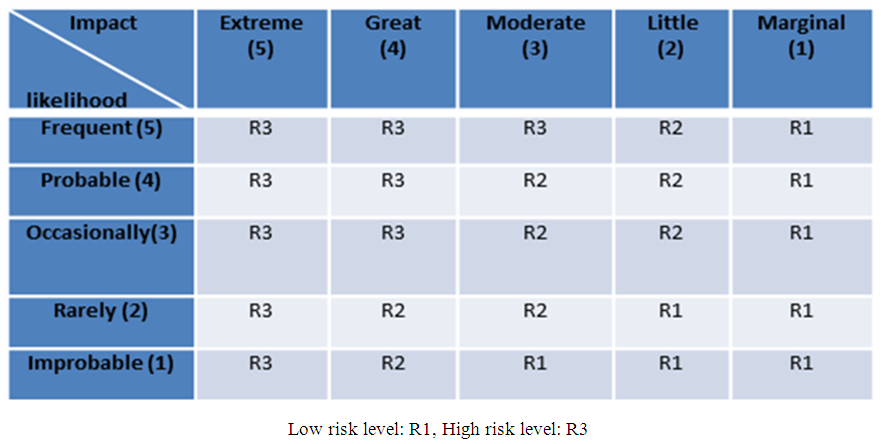 | Figure 3. Risk Acceptability Matrix (RAM) (Categorisation) |
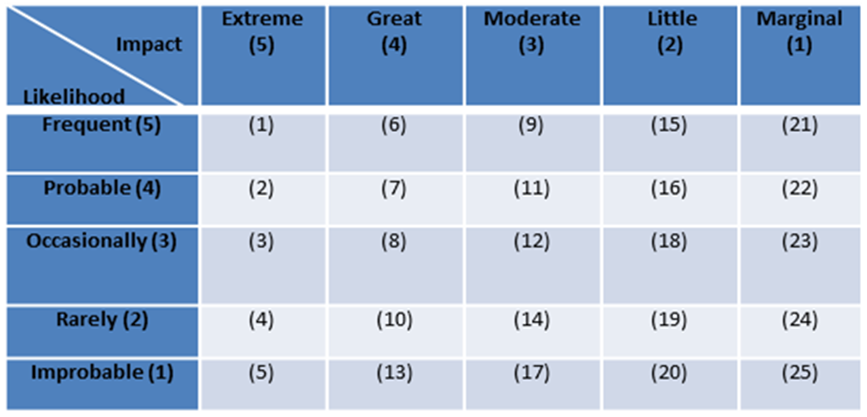 | Figure 4. Risk Acceptability Matrix (RAM) (Prioritisation) |
|
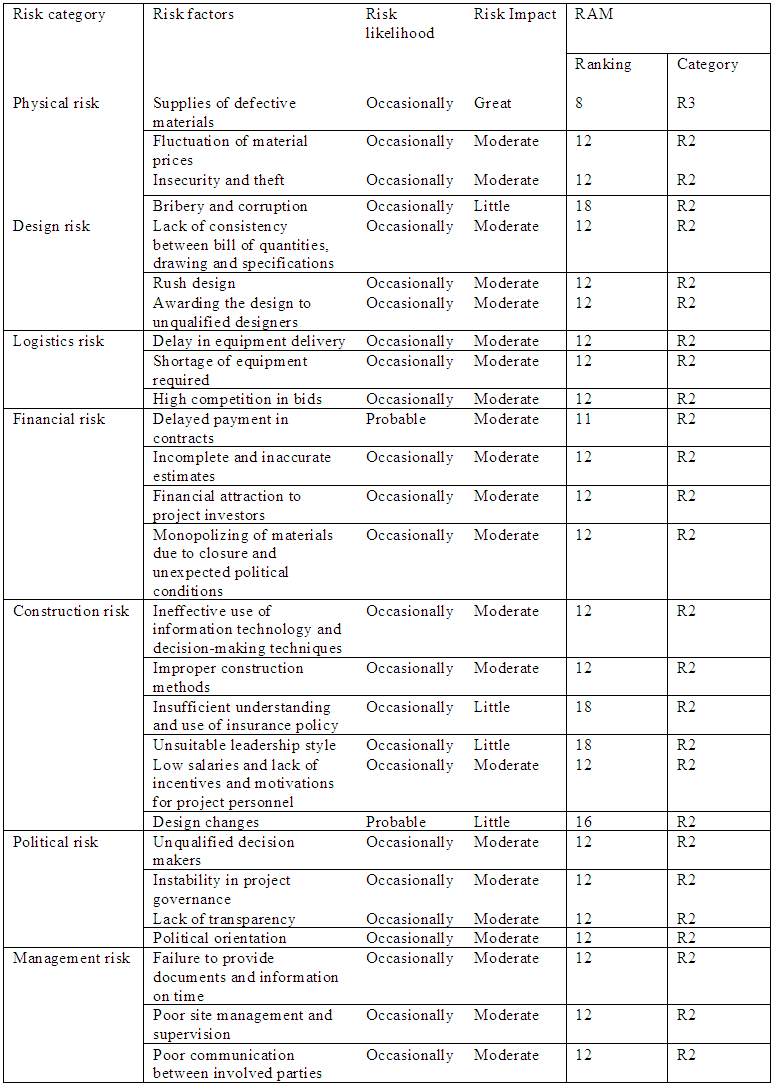 | Table 5. Assessment of risk factors using RAM |
4.3. A Bayesian Belief Network Building Construction Project Modelling Using Netica Software
- After the relevant risk factors were assessed and classified, the interaction between them was analysed in a Bayesian belief network model. The Bayesian belief network was constructed by structural and parameter learning using the Netica version 5.0, which is a type of BBN decision software.The relationship between the risk factors was determined through subjective judgement of the researcher based on the literature on risk factors affecting building construction projects and also on the results from the data collected on risk factors during the case study in the construction industry. The Netica software V5 by means of visual representation linked the interactions of the risk factors to determine their cause and effect relationships and risk level in building construction projects. The risk factors were then analysed to determine how they resulted in cost overruns, quality assurance issues and time overruns on projects. Figure 5 shows the graphical output of the BBN model that could support risk management in building construction projects especially in Nigeria. Netica software enabled identification of the network of risk factors and the relationship between them in a graphical model. It becomes easy to trace relevant risk factors and their cause and effect relationships.
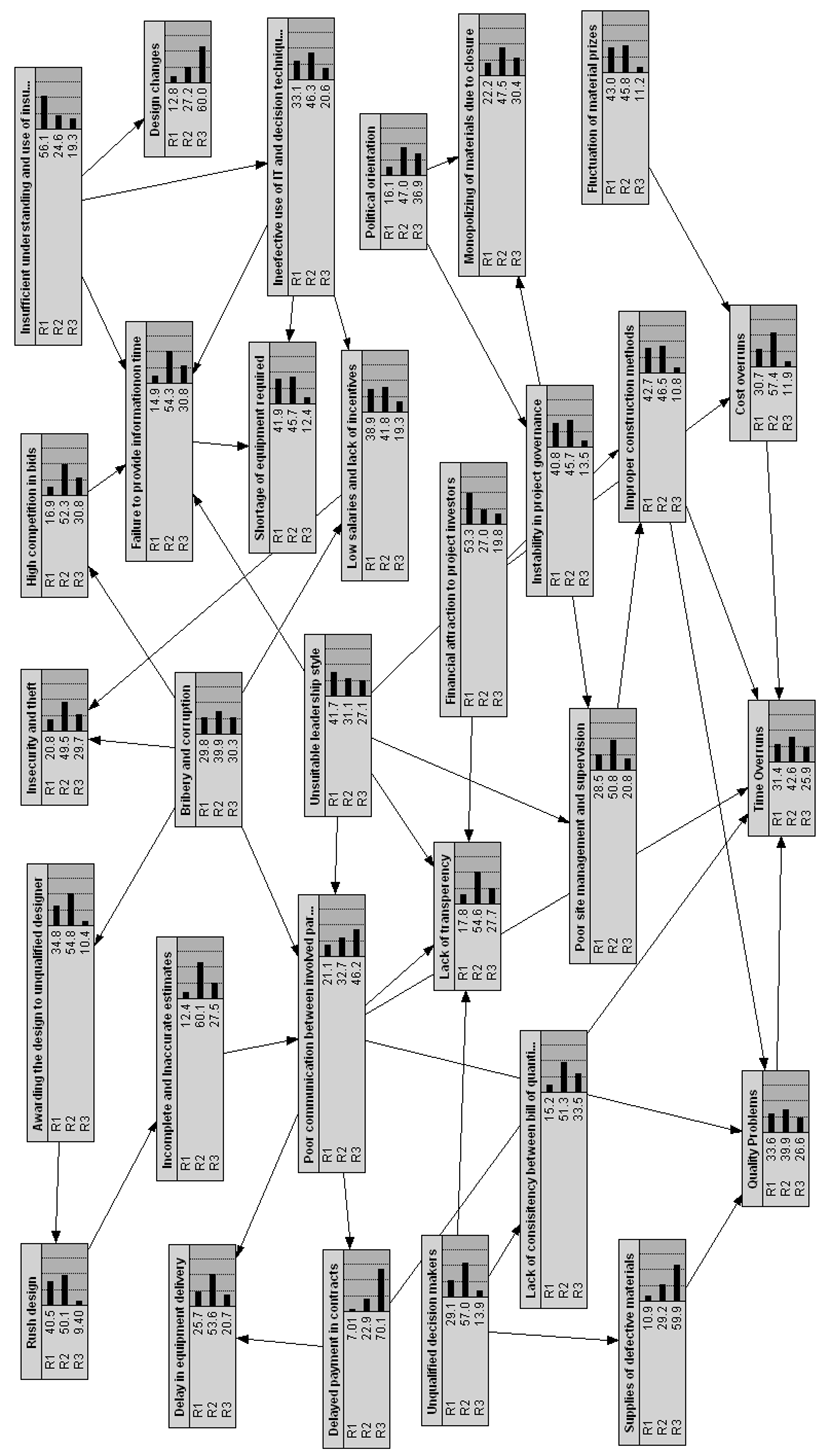 | Figure 5. A Bayesian belief newtwork model for buiilding construction projects in Nigeria |
4.4. Risk Control Strategies in the Mitigating Concept
- Based on construction of Bayesian belief network (BBN), sensitivity analysis is carried out using the Netica software to measure the degree to which the outcome at any node can influence the beliefs at another node, giving the values currently entered [18]. The measures are in the form of entropy reduction, or the expected reduction of real variance. Sensitivity is represented by entropy where large entropy could be influenced by a single finding at each of the other nodes in the network [18]. This suggests that where the entropy values for risk factors on a node are high, then those factors have the highest influence on that project performance variable occurring.Sensitivity analysis was conducted for the nine proximal risk factors identified in the BBN model shown in Figure 5. Entropy reduction or mutual information values were calculated for sensitivity analysis using Netica V5 software for the 9 risk factors identified to directly affect project performance. Table 6 shows the results of the sensitivity analysis and entropy reduction data.
|
5. Conclusions
- This study has presented a methodology for building construction project risk assessment using the Bayesian Belief Network (BBNs). The procedure was applied to the Nigerian construction sector, highlighting the relationship among risk factors. In total, 76 risk factors were identified through literature review and expert interviews. A questionnaire survey was also conducted of 343 (305 contractors/subcontractors and 38 clients) randomly selected samples within the Nigerian construction sector. As a result, 27 significant risk factors that affected project performance in the Nigerian building construction sector were identified from the survey.Overall, critical risk factors identified from the Risk Acceptability Matrix (RAM) for a BBN analysis were supplies of defective materials, poor site management, delayed payment in contracts, incomplete and inaccurate estimates, lack of transparency, political orientation, insecurity and theft, poor communication between involved parties and unqualified decision makers.The Bayesian belief network as proposed for construction risk assessment in this study allows inference based on observation and also calculation of conditional probabilities of risk factors. In the analysis of risk factors directly related to building construction project performance in the BBN model, time overruns and quality problems were more significant risks than those posed by cost overruns in building construction projects in Nigeria. Quality problems were directly related with improper construction methods, poor communication between involved parties of the project and supplies on defective materials. Time overruns was directly related to improper construction methods, poor communication between involved parties and delayed payments on contracts in the Nigerian context. Cost overruns were directly related to fluctuation in material prices and unsuitable leadership style. The Bayesian belief network is used for building construction risk assessment because they allow inference based on observation and calculate conditional probabilities of risk factors.A properly implemented risk management process will enhance the successful completion of building construction projects and thereby make the project more profitable. In a building construction project where cost, time and quality really matters, executing a project within the specified budget, time frame and optimal quality is critical. Thus, risk assessment is a critical procedure for decision-making and projecting success. This methodology is robust and can be applied to a variety of decision-making and sensitivity analysis in the building construction sector. Bayesian belief network is more flexible to use more than other statistical analysis methods and modelling tools available for risk assessment and management.
 Abstract
Abstract Reference
Reference Full-Text PDF
Full-Text PDF Full-text HTML
Full-text HTML